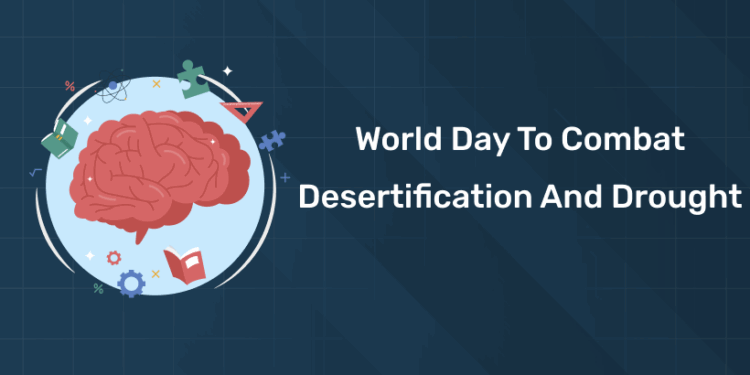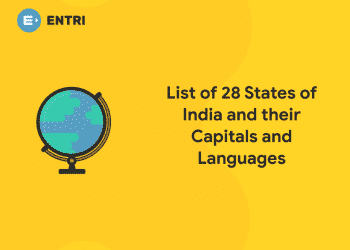Table of Contents
The UN General Assembly officially declared the desertification and drought day as “World Day to Combat Desertification and Drought”. This day, as the name suggests, signifies raising awareness and public support in the community, to carry out ways of cooperation and attempts to combat desertification and drought across the world. Hence, the World Day to Combat Desertification and Drought is celebrated on 17 June every year.
Established in 1944, the United Nations Convention to Combat Desertification(UNCCD), links environment and evolution to sustainable land management. Costa Rica is chosen this year as the host of the global observance. This year, the UNCCD will work with the Ministry of Environment(MINAE) of Costa Rica to uplift the household, community and the countries to have a better bonding with nature as we relapse from the pandemic. Therefore, let us dig deeper and understand the importance behind the existence of this day.
World Day to Combat Desertification and Drought 2025 Date – June 17
In this article readers can get a glimpse on
- History and Objective of World Day to Combat Desertification and Drought
- World Day to Combat Desertification and Drought Theme 2025
- World Day to Combat Desertification and Drought Quiz
History and Objective of World Day to Combat Desertification and Drought
1: Who was the first woman President of India?
The World Day to Combat Desertification and Drought was officially proclaimed by the United Nations General Assembly in 1994. This followed the adoption of the United Nations Convention to Combat Desertification (UNCCD), which remains the only legally binding international agreement linking environment and development to sustainable land management. The first observance took place in 1995, aiming to raise awareness and rally global support to address desertification, land degradation, and drought (DLDD).
This day highlights the growing challenges of dryland degradation, especially in vulnerable regions such as Sub-Saharan Africa, Latin America, and parts of Asia. Each year, the observance promotes public participation and cooperation at all levels—local, national, and international—to improve land productivity and resilience. It brings attention to successful examples of land restoration, encourages sustainable farming, and pushes for the integration of DLDD into national policies.
The objective of the day is not only to inform people about desertification and drought but also to inspire action. It supports efforts toward achieving Land Degradation Neutrality (LDN) by 2030, as outlined in the Sustainable Development Goals (SDGs). Individuals, communities, and governments are encouraged to adopt practices that conserve soil, reduce water use, and protect ecosystems. Ultimately, the day promotes a vision of healthy land sustaining healthy lives and livelihoods.
Free UPSKILLING Courses!
Take your first step toward mastering in-demand skills, acing interviews, and securing top-tier jobs with Entri's free upskilling courses.
Start Learning!What is Desertification?
Desertification is an environmental issue that is expanding alarmingly. Desertification is the continuous land degradation in drylands that tampers the normal balance of the ecosystem and biological productivity due to climatic variations or by human activities, by means of which fertile land becomes completely barren. Except for Antarctica, desertification occurs on all continents, affecting the livelihoods of millions of people, especially a large population of the poor living on drylands. The U.N. Convention to Combat Desertification (UNCCD) defines it as “land degradation in arid, semiarid and dry subhumid areas resulting from various factors, including climatic variations and human activities.”
Causes and Effects of Desertification
Climatic variations and human activities can be regarded as the two main causes of desertification. In short, the other factors that contribute to the causes of desertification are as follows.
- Urbanization
- Overgrazing
- Climate change
- Deforestation
- Overuse of groundwater
- Natural disaster
- Excessive use of fertilizers and pesticides
- Mining
- Farming practices
- Soil pollution
- Stripping the land of resources
The effect of desertification is a vicious circle. Desertification affects the human race to a submissively large extent. To clarify, mentioned below are some of the effects of desertification.
- Shortage of food
- Decrease in crop yields
- Flooding
- Farming becomes impossible
- Crowding and overpopulation
- Migration
- Destruction of habitat
- Extinction and endangerment of species
- Biodiversity loss
- Poor water quality
Solutions to Desertification
Although the world is facing the challenge of desertification, there are solutions, if implemented well, will reduce the effects of desertification. Delve into the solutions below for a clear understanding.
- Smart farming techniques
- Reforestation
- Education
- Advancement in technology
- Restricting mining practices
- Reinforcing rehabilitation efforts
There are also some strategies to reduce the impact of desertification. Prevention of desertification is better than rehabilitation.
- Plant more trees- The roots of the trees helps in holding the soil which in turn will prevent soil erosion.
- Water management- Storing water in earth dams during the wet season can help in utilizing it for irrigation during the dry season. Using technologies like the drip irrigation method and the magic stones method are examples of water management in the desert environment.
- Improving the quality of the soil- By reducing the number of grazing animals and growing crops instead, the quality of the soil can be improved. And animal manure can be used to fertilize the crops which in turn will grow well. Growing crops in this way can improve the quality of the soil as it is held together by the roots of plants and protected from erosion. This is a sustainable type of farming.
Why Do We Observe Desertification and Drought Day?
How does desertification affect us? No matter where we live, the consequences of desertification and drought is a global concern, although. 23 per cent of the world’s land is no longer productive. 75 per cent has been transformed from its natural state, for agriculture purpose. As a result, this transformation in the usage of land is happening at a much faster rate in human history. This usage of land has accelerated over the last five decades. In the end, everyone needs to know that desertification, land degradation and drought have a direct effect on their daily lives and that everyone’s daily actions can contribute to help fight these problems.
World Day to Combat Desertification and Drought 2025 Theme
The 2025 theme, “Restore the land. Unlock the opportunities,” highlights the powerful link between land restoration and human progress. It emphasizes how degraded land, once revived, can support food security, create jobs, and build resilience to climate change. By restoring land, communities can reverse damage caused by deforestation, poor agricultural practices, and overgrazing. This theme calls on individuals, governments, and businesses to see land restoration not as a burden but as an investment in long-term sustainability and prosperity.
This theme also promotes the idea that healthy land opens doors to economic, social, and environmental opportunities. From improved agricultural yields to cleaner air and water, the benefits of restoration are wide-ranging. It aligns with the global goals for land degradation neutrality and encourages all stakeholders to take part in restoring ecosystems. The 2025 observance serves as a reminder that the future of our planet depends on the health of its land—and that restoring it is key to unlocking opportunity for all.
Free UPSKILLING Courses!
Take your first step toward mastering in-demand skills, acing interviews, and securing top-tier jobs with Entri's free upskilling courses.
Start Learning!World Day to Combat Desertification and Drought Previous Themes
World Day to Combat Desertification and Drought, observed annually on June 17, was established by the United Nations General Assembly in 1994 to promote public awareness of international efforts to combat desertification and the effects of drought.
Here are the themes from recent years:
- 2008: Combating land degradation for sustainable agriculture
- 2009: Conserving land and water = Securing our common future
- 2010: Enhancing soils anywhere enhances life everywhere
- 2011: Forests keep drylands working
- 2012: Healthy soil sustains your life: Let’s go land degradation neutral
- 2013: Drought and water scarcity
- 2014: Land belongs to the future – Let’s climate-proof it!
- 2015: Attainment of food security for all through sustainable food systems: “No such thing as a free lunch. Invest in healthy soils.”
- 2016: Protect Earth. Restore Land. Engage People.
- 2017: Our Land. Our Home. Our Future.
- 2018: Land has true value – Invest in it!
- 2019: “Let’s Grow the Future Together”
- 2020: “Food. Feed. Fibre. The links between consumption and land degradation.”
- 2021: “Restoration. Land. Recovery. We build back better with healthy land.”
- 2022: “Rising up from drought together”
- 2023: “Her Land. Her Rights.”
- 2024: “United for Land. Our Legacy. Our Future.”
- 2025: “Restore the Land. Unlock the Opportunities.”
World Day to Combat Desertification and Drought Quotes
- Don’t let our future dry up. Conserve water and save the planet from droughts. Wish you a very happy World Day to Combat Desertification and Drought.
- Put your Greenheart at work on 17th June and save the environment. Happy World Day to Combat Desertification and Drought.
- Put your Greenheart at work on 17th June and save the environment. Happy World Day to Combat Desertification and Drought.
- Join the fight, Conserve Land and Energy and secure our common future by preventing desertification and droughts. Best wishes on World Day to Combat Desertification and Drought.
- “Our land, our home, our future.” Save it and work towards securing our future. Wish you a happy World Day to Combat Desertification and Drought.
World Day to Combat Desertification and Drought Quiz 2025
A) UNEP
B) UNDP
C) UNCCD
3. What is desertification?
A) Loss of glaciers
B) Land degradation in arid areas
C) Deforestation in rainforests
A) 20%
B) 40%
C) 60%
5.Which sector is most affected by drought and desertification?
A) Technology
B) Agriculture
C) Education
A) Europe
B) Asia
C) Africa
A) Mining
B) Deforestation
C) Space exploration
A) Ocean pollution
B) Reduced soil fertility
C) Volcanic eruptions
A) No change in land quality over time
B) Balance between degraded and restored land
C) Complete ban on farming
Want More Engaging Questions?
Download our FREE PDF packed with insightful quiz questions to test your knowledge!
🔽 Click below to get your free copy now! 🔽
World Day to Combat Desertification and Drought Quiz 2025 PDF
The future of the whole world is at stake and we have a huge role to play. Above all, people exploit nature’s land for fulfilling their never-ending selfish needs. Therefore, on this day, the organizations hold meetings and conduct workshops to create awareness and highlight the suggestions to overcome such human activities.
In conclusion, the ultimate goal this year is to recover from the insinuations of the pandemic. Our land has a major role in our quest to recover from the economic and climatic crisis of this pandemic. As a result, let us help heal our Earth by contributing and doing our part. Remember, a small step can go a long way.
In short, we hope this article helped you get an insight into the depth of the matter of desertification and drought and made you understand the gravity of the World Day to Combat Desertification and Drought.
Free UPSKILLING Courses!
Take your first step toward mastering in-demand skills, acing interviews, and securing top-tier jobs with Entri's free upskilling courses.
Start Learning!Frequently Asked Questions
What is desertification?
Desertification is the process where fertile land becomes dry and unproductive. It mainly affects arid, semi-arid, and dry sub-humid areas. This happens due to factors like deforestation, overgrazing, and poor land management. It reduces the land’s ability to support crops, animals, and people.
Why is desertification a global concern?
Desertification threatens the livelihoods of millions of people worldwide. It causes food insecurity, water scarcity, and poverty in affected regions. It also worsens the impacts of climate change by releasing stored carbon. Addressing desertification helps protect ecosystems and human well-being globally.
What is the United Nations Convention to Combat Desertification (UNCCD)?
The UNCCD is an international treaty adopted in 1994 to tackle desertification and land degradation. It brings together nearly 200 countries committed to sustainable land management. The convention promotes policies and actions to restore degraded lands. It aims to improve livelihoods and maintain ecosystem health.
How does drought relate to desertification?
Drought is a natural phenomenon where rainfall is below average for a prolonged period. It stresses soil and vegetation, making land more vulnerable to degradation. Repeated droughts accelerate desertification by reducing plant cover and soil fertility. Managing drought impacts is key to preventing further land degradation.
What are drylands?
Drylands are areas with low or unpredictable rainfall, covering about 40% of the Earth’s land surface. They include deserts, semi-deserts, and dry savannas. These regions are home to over 2 billion people, many relying on agriculture and livestock. Drylands are especially vulnerable to desertification and drought.
What causes desertification?
Desertification results from a combination of natural and human factors. Unsustainable farming, deforestation, overgrazing, and improper irrigation practices damage soil and vegetation. Climate change and prolonged droughts worsen the problem. Preventing desertification requires sustainable land and water management.
How can desertification be prevented or reversed?
Preventing desertification involves adopting sustainable land use practices like crop rotation, agroforestry, and controlled grazing. Reforesting degraded areas and restoring soil fertility are effective methods. Efficient water management and drought-resistant crops also help. International cooperation and local community involvement are essential.
What is Land Degradation Neutrality (LDN)?
LDN is a goal to balance the amount of degraded land with restored or sustainably managed land. It aims to keep the overall land quality stable or improve it over time. Achieving LDN supports food security, biodiversity, and climate resilience. Many countries have committed to LDN targets under global agreements.
How does desertification impact biodiversity?
Desertification reduces habitat quality and availability for many plants and animals. It causes the loss of species adapted to fertile and stable soils. Declining biodiversity weakens ecosystem functions like nutrient cycling and water regulation. Protecting land health helps conserve diverse species and ecosystem services.
How can individuals contribute to combating desertification?
Individuals can conserve water, plant trees, and support sustainable agriculture practices. Avoiding soil erosion by planting ground cover and reducing deforestation helps too. Raising awareness and supporting policies for land restoration is important. Small actions combined can make a significant impact on land health.











